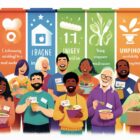Non-profits’ Impact on Stamp Distribution for Nutrition

You won’t believe the transformative impact non-profits have on stamp distribution for nutrition. These organizations, through collaborative efforts with government agencies, community outreach, and education programs, are increasing accessibility to SNAP benefits.
By expanding food distribution networks and improving nutritional outcomes for vulnerable populations, non-profits are making a measurable difference. This article delves into the data-driven analysis of their efforts, shedding light on the vital role they play in ensuring everyone has access to healthy and nutritious food.
Key Takeaways
- Non-profits play a crucial role in increasing accessibility to SNAP benefits by providing outreach and education to eligible individuals and families.
- Collaborative efforts between non-profits and government agencies help streamline the application process and raise awareness about SNAP benefits.
- Community outreach and education programs organized by non-profits empower individuals to make informed choices regarding their nutritional needs.
- Non-profits contribute to improving nutritional outcomes for vulnerable populations by strengthening food distribution networks and addressing food insecurity.
Increasing Accessibility to SNAP Benefits
In the article, we’ll explore how non-profits can enhance the accessibility of SNAP benefits.
One way non-profits can achieve this is by providing outreach and education to eligible individuals and families. According to a study conducted by the Urban Institute, many people who are eligible for SNAP benefits aren’t aware of their eligibility or how to apply for them. Non-profits can bridge this knowledge gap by conducting informational sessions, workshops, and distributing educational materials in communities with high rates of food insecurity. By raising awareness about SNAP benefits and simplifying the application process, non-profits can help more individuals and families access the nutritional support they need.
Additionally, non-profits can collaborate with local businesses and farmers’ markets to increase the availability of fresh and healthy food options for SNAP recipients. The United States Department of Agriculture (USDA) has implemented the SNAP Farmers Market Initiative, which allows SNAP beneficiaries to use their benefits to purchase fresh produce directly from participating farmers’ markets. Non-profits can play a crucial role in connecting farmers’ markets with SNAP recipients and promoting the benefits of purchasing locally sourced food.
Furthermore, non-profits can work towards reducing barriers to access by advocating for policy changes and improvements in the SNAP program. They can engage in data-driven research to identify areas where the program could be more efficient and inclusive. By partnering with government agencies and policymakers, non-profits can contribute to the development of innovative solutions that enhance the accessibility and effectiveness of SNAP benefits.
Collaborative Efforts With Government Agencies
To continue the discussion from the previous subtopic, you can enhance the accessibility of SNAP benefits by collaborating with government agencies. By forming partnerships with these agencies, non-profit organizations can leverage their resources and expertise to improve the distribution of nutrition assistance to eligible individuals and families.
Here are three ways in which collaborative efforts with government agencies can have a significant impact:
- Streamlined application process: Non-profits can work alongside government agencies to develop user-friendly application systems that reduce barriers to access. By simplifying the application process and providing assistance to applicants, the collaboration can help ensure that more eligible individuals receive the benefits they need.
- Targeted outreach campaigns: Government agencies often face challenges in reaching vulnerable populations who may be unaware of or hesitant to apply for SNAP benefits. Non-profits can use their local networks and community connections to conduct targeted outreach campaigns, raising awareness about the program and providing guidance on eligibility criteria and application procedures.
- Data sharing and analysis: Collaboration between non-profits and government agencies can facilitate the sharing of data and information. By analyzing this data, organizations can identify gaps in service delivery, track program effectiveness, and make data-driven decisions to improve the distribution of SNAP benefits.
Through collaborative efforts with government agencies, non-profits can play a crucial role in enhancing the accessibility and effectiveness of SNAP benefits. By leveraging their unique strengths and resources, these partnerships can make a tangible difference in addressing food insecurity and improving the overall well-being of individuals and families in need.
Community Outreach and Education Programs
Continue the discussion from the previous subtopic by implementing community outreach and education programs to further enhance the impact of non-profits’ collaborative efforts with government agencies.
Community outreach plays a crucial role in raising awareness about nutrition assistance programs and ensuring that eligible individuals are informed about their benefits. By organizing events and workshops, non-profits can directly engage with the community and educate them on the importance of healthy eating and how to make the most of their food stamps.
Education programs are equally important in empowering individuals to make informed choices regarding their nutritional needs. By providing workshops on meal planning, budgeting, and cooking nutritious meals, non-profits can equip recipients with the knowledge and skills necessary to improve their overall health. These programs can also address specific dietary needs, such as diabetes management or heart-healthy eating, to ensure that recipients are able to make choices that align with their individual health goals.
Data-driven approaches can further enhance the effectiveness of community outreach and education programs. By analyzing demographic data, non-profits can identify target populations that may be at a higher risk of food insecurity or malnutrition. This allows them to tailor their outreach efforts and education programs to address the specific needs of these populations.
Expanding Food Distribution Networks
Expand your impact by establishing and strengthening food distribution networks to ensure that nutritious food reaches those in need. By expanding your network, you can increase the reach and efficiency of your food distribution efforts, ultimately improving the nutritional outcomes for vulnerable populations.
Here are three key benefits to consider:
- Increased Access: By establishing partnerships with local farmers, grocery stores, and food suppliers, you can expand your access to a wider variety of nutritious food options. This allows you to provide a more diverse and balanced diet to those in need, addressing nutritional deficiencies more effectively.
- Improved Logistics: Strengthening your distribution networks enables you to optimize the logistics of food delivery. By establishing efficient transportation routes, coordinating with local food banks, and utilizing technology for tracking and inventory management, you can minimize food waste and ensure timely delivery of fresh produce and other perishable items.
- Enhanced Collaboration: Expanding your network fosters collaboration among various stakeholders, including non-profit organizations, government agencies, and community volunteers. By working together, you can leverage shared resources, expertise, and funding opportunities, ultimately maximizing the impact of your food distribution efforts.
By focusing on expanding your food distribution networks, you can better address the nutritional needs of vulnerable populations, reducing food insecurity and improving overall health outcomes.
Now, let’s explore how improving nutritional outcomes for these populations can be achieved.
Improving Nutritional Outcomes for Vulnerable Populations
By further strengthening your food distribution networks, you can actively contribute to improving the nutritional outcomes for vulnerable populations. Access to nutritious food is crucial for the well-being and development of individuals, especially those who are at a higher risk of malnutrition due to socioeconomic factors. According to data from the World Health Organization, over 820 million people worldwide suffer from chronic undernourishment, with the majority being women and children in low-income countries.
To address this issue, it’s essential to focus on enhancing the availability and accessibility of nutritious food options for vulnerable populations. This can be achieved by partnering with local farmers and producers to ensure a steady supply of fresh and healthy food items. Additionally, implementing community-based initiatives such as community gardens and farmers’ markets can also help increase access to nutritious food for underserved communities.
Furthermore, it’s crucial to provide education and awareness programs that promote healthy eating habits and nutrition knowledge. This can be done through workshops, cooking demonstrations, and collaboration with local healthcare providers to ensure that individuals have the necessary information to make informed choices about their diet.
Frequently Asked Questions
How Do Non-Profits Contribute to Increasing Accessibility to SNAP Benefits?
Non-profits contribute to increasing accessibility to SNAP benefits by collaborating with government agencies, providing outreach and education, and streamlining the application process. Their efforts result in more individuals and families receiving the nutrition assistance they need.
What Are Some Examples of Collaborative Efforts Between Non-Profits and Government Agencies to Improve Stamp Distribution for Nutrition?
Collaborative efforts between non-profits and government agencies improve stamp distribution for nutrition. Examples include partnerships to streamline application processes, expand eligibility criteria, and develop innovative outreach strategies. These initiatives aim to increase accessibility and support healthier food choices.
How Do Non-Profits Conduct Community Outreach and Education Programs to Raise Awareness About SNAP Benefits and Nutrition?
Non-profits conduct community outreach and education programs to raise awareness about snap benefits and nutrition. They reach out to individuals and communities, providing information, resources, and support to help them make healthier choices and access the benefits they are entitled to.
What Strategies Do Non-Profits Employ to Expand Food Distribution Networks and Ensure Access to Nutritious Food?
Non-profits expand food distribution networks and ensure access to nutritious food through strategies like partnering with local farmers, establishing community gardens, and collaborating with grocery stores to donate surplus food.
How Do Non-Profits Work Towards Improving Nutritional Outcomes for Vulnerable Populations Through Their Initiatives?
Non-profits improve nutritional outcomes for vulnerable populations through various initiatives. They focus on expanding food distribution networks, ensuring access to nutritious food, and implementing programs that educate and empower individuals to make healthy choices.



